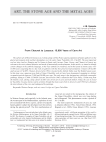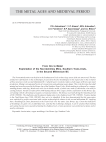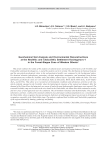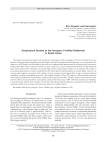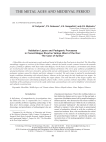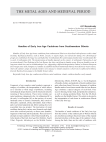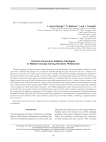Archaeology, Ethnology & Anthropology of Eurasia @journal-aeae-en
Статьи журнала - Archaeology, Ethnology & Anthropology of Eurasia
Все статьи: 524

Floral designs on sacrificial towels from an old believers' Prayer house
Статья
We reconstruct the semantics of fl oral compositions on commemorative towels, embroidered by women, members of the Old Believers Bespopovtsy (priestless worship community rejecting marriage) in Novosibirsk. The original vine motif, associated with the funerary cult, was transformed by replacing vines with more familiar motifs, such as fl owers, berries, buds, etc. Certain designs resemble those found in late 19th to early 20th century embroidery manuals and on wrappers of cheap soap manufactured by Rallet, Brocard, etc. In most cases, however, there are no exact parallels. Some fl oral compositions are original: for instance, those showing vases with scrolls reminiscent of Jesus Christ’s monogram, and “vases” turned into letters on Our Savior’s icons. The results of the technological and stylistic analyses suggest that most sacrifi cial towels were made in the late 1800s and early 1900s, some in the 1940s and 1950s, and some may have been manufactured in places of the Old Believers’ former residence in northern and central Russia. Designs arranged in friezes or central fi gures, such as crosses, cruciate motifs, “vases”, or “vaults”, allude to the Old Believers’ fundamental values. Ritual towels evidence motifs on commercial embroideries creatively transformed by Old Believers according to their beliefs and traditions.
Бесплатно
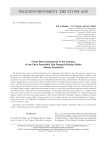
Статья научная
We describe three processed fossilized bones of sea mammals of the Miocene age, discovered in various years, but in similar stratigraphic and planigraphic contexts, at the Early Paleolithic site Bogatyri/Sinyaya Balka, on the northern coast of the Taman Peninsula. We provide information on the age, stratigraphy, and planigraphy of the site, interpreted as a place for butchering carcasses of elephants and rhinoceroses (elasmotheres). Results of traceological analysis suggest that two fossilized seal bones had been split by the counterstrike technique on soft (wooden or bone) anvils, while the third bone had been more thoroughly processed. All three specimens may have been collected from coastal deposits. Fossilized seal bones were evidently used as raw material along with rocks and animal bones of the Taman faunal complex. Small and inconvenient as they are, such bones provided the hardest isotropic material available at the site. That their use was not incidental is convincingly demonstrated by artifact No. 1, found in 2005. The point made on this bone is situated in the middle of an intentionally prepared blade, in a notch fashioned by shallow retouch. This bone tool is quite similar to other points in the Early Paleolithic industry of Bogatyri/Sinyaya Balka. Tools of that category differ in shape and size, but are similar because of a special morphological element— a point (bec, borer, etc.) shaped by a combination of retouch and small encoches at any suitable place in the blank such as jointing or spall.
Бесплатно
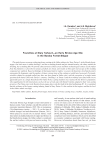
Foundries at Stary Tartas-5-an early bronze age site in the Baraba forest-steppe
Статья
This study focuses on areas evidencing bronze casting at the Odino culture site, Stary Tartas-5, in the Baraba foreststeppe. One such area is within dwelling 1 and has a smelting hearth and pits situated nearby; the other, outside the dwelling, has a smelting kiln. We provide characteristics of these areas and their archaeological context. Each artifact from the foundries is described in detail, parallels are listed, and results of binocular microscopy of the molding compound are outlined. Based on fi ndings of thermogravimetric studies, we assess the functions of technical pottery represented by fragments, and the number of times various items of the casting set could have been used. Previously, crucibles shaped as straight-walled jars have not been found at Odino sites, with the exception of a single intact specimen from burial 286 at the Tartas-1 cemetery. Dwelling 1 at Tartas-5 and the workshop associated with it were apparently parts of a single household. The Odino bronze casting tradition was retained by the Krotovo population, who supplemented it with innovations, such as the use of oval cups with thicker bottoms adapted to their own casting practices. The Odino sites in the Baraba forest-steppe date to the fi rst half of the third millennium BC. It is concluded that the evidence of the bronze casting industry found at Stary Tartas-5 is the earliest in that region, and that its level in the Odino culture was high.
Бесплатно
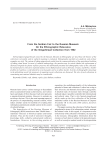
Статья
Serbian fi gured gingerbreads owned by the Russian Museum of Ethnography are described, the history of the collection is provided, and its cultural meaning is evaluated. Ethnographic parallels are analyzed, and archaic examples are cited. The custom of baking gingerbread results from the commercialization of the agricultural tradition of baking ritual bread. In terms of cultural anthropology, the question may be raised whether the replacement of destroyed originals by plaster replicas preserves the information potential and ethnographic value of the collection. Its interpretation is relevant to national identity in new Balkan nations such as Slovenia, Croatia, and Serbia. Another problem is if and how a craft shared by several peoples can be an ethnic marker. In terms of ethnographic museology in the globalizing world, the prospects of acquiring recent collections are discussed. The role of such collections in constructing new national identities may be considerable.
Бесплатно
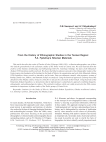
From the history of ethnographic studies in the Yenisei region: F.A. Fjelstrup’s Siberian materials
Статья научная
This article describes the works of Theodor (Fedor) Fjelstrup (1889–1933)—a Russian ethnographer, one of those who laid the groundwork for the systematic studies of the Turkic world of Central Asia. We used materials from the archives of the Institute of Ethnology and Anthropology RAS (F.A. Fjelstrups' holding): the diary of the Minusinsk- Abakan 1920 Expedition and the notebook. We discuss the hitherto unknown episodes in the ethnographic studies of the Yenisei region, the foundation of the Institute for the Study of Siberia, the organization and work of the Minusinsk-Abakan 1920 Expedition, whose records we introduce, and its route. Data on settlements, utensils, clan structures, systems of kinship, family rites, folklore, and shamanic beliefs are analyzed. Using the historical approach, Fjelstrup traced the dynamism of the Khakas culture, being one of the fi rst to discuss the syncretism of their beliefs. Using materials of the Minusinsk-Abakan Expedition, we demonstrate that he implemented a comprehensive approach combining linguistic, ethnographic, and anthropological evidence. This scholarly tradition, which was widely practiced in the 20th century, maintains its importance in future studies of the Turkic groups of Central Asia.
Бесплатно

Gazma cave-a final Middle Paleolithic site in Azerbaijan: paleogeography, chronology, archaeology
Статья научная
This article describes the Middle Paleolithic industry of Gazma Cave in the Nakhchivan Autonomous Republic of Azerbaijan. We present data on the stratigraphy, paleontology, chronology, and archaeology of the site. Six lithological layers were identifi ed, three of which (IV–VI) contain abundant archaeological material. The chronology of the site is based on a series of luminescence ages. The deposition of layers IV–VI formed ~55–40 ka BP. Paleontological, pollen, and grain size analysis offer the possibility of reconstructing Late Pleistocene environments around the cave. Faunal analysis indicates steppe, semi-steppe, and wooded mountains, with riparian forests and reeded areas in the fl oodlands. The analysis of 896 artifacts attests to the predominance of Levallois and parallel reduction. The share of Levallois blanks is high. The most common artifacts are Levallois and Mousterian points and side-scrapers; there are also limaces, knives, and a few indistinct Upper Paleolithic types such as end-scrapers and borers. Ventral basal trimming of points and ventral or dorsal thinning of side-scrapers were widely used. All the main indicators show the Gazma industry corresponds to the fi nal Middle Paleolithic assemblages currently known in the Southeastern Caucasus.Gazma is an expressive MIS 3 example of the Taglar industry.
Бесплатно

Geomorphology and quaternary sediments at archaeological sites near Anzhevka, Krasnoyarsk territory
Статья
Бесплатно

Geophysical studies at the Kushmanskoye (Uchkakar) fortified settlement, Kama basin
Статья
Бесплатно

Статья научная
This article describes the findings of excavations of an Early Saka kurgan at Kyrykoba, Eastern Kazakhstan. The kurgan had been looted; human remains, according to physical anthropologists, belonged to a mature woman. Her cranium exhibited trepanation. Some 200 artifacts were found, mostly gold and stone ornaments (belt clips, gold seed beads, and simple beads). The most interesting find is a bimetallic pin made of iron. Its rod is missing; the tiny head, less the 1 cm in diameter, is covered with gold foil. On its surface, there is a figure of an ungulate with a curved antler, its body twisted 180°. This stylistic device in the depiction of ungulates and predators is typical of the Scythian-Siberian art of Kazakhstan and Western Siberia in 700–300 BC. Other rare finds include ornaments made from a cretaceous layer of oyster shells, such as pendants shaped as oval plates imitating tusks, or figurines of predatory animals— 20 pieces, ranging in size from 0.4 × 0.4 to 2.5 × 2.5 cm. Oyster shells with thick cretaceous layers had been procured from the coasts of the Indian Ocean and the Persian Gulf. The beads and the animal figurine made from cretaceous layers of oyster shells are paralleled by those from an Early Scythian era burial at Gilevo-10, Altai. These artifacts indicate regional and intracontinental trade and cultural ties in Eastern Kazakhstan and Western Siberia, evidenced by similar technological traditions, images, compositions, and decorative motifs.
Бесплатно
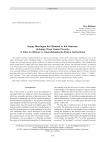
Статья научная
This study examines traditional ideas of women and marriage, based on the instructions attributed to one of the rulers of the epoch of the “Religious Kings”—Usun-Debeskertu-Khan, and his ministers. The focus is made on female virtues, the most important of which is adherence to duties in relation to the husband and children. The standards that noble women had to comply with were higher than those concerning other women, but still quite realistic, as attested to by historical records. Negative female traits were said to be caused by untamed emotions, which cause one to forget about commonly accepted norms of behavior. The analysis of the instructions relating to marriage suggests that they were especially influenced by Buddhism, which, using various forms of instruction, including didactic writings, endowed marriage with a new, spiritual content. There were three forms of marriage, tentatively described as “divine”, “earthly”, and “infernal”. The causes of happy and unhappy marital unions were believed to be mainly related to women’s properties mentioned in the instructions. Marital harmony was said to depend mostly on the woman.
Бесплатно

